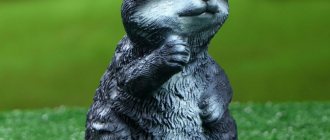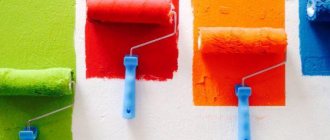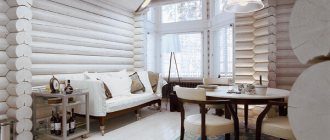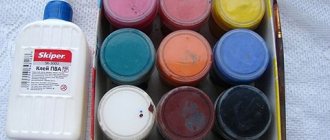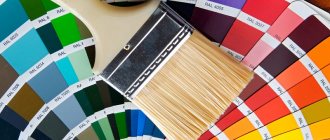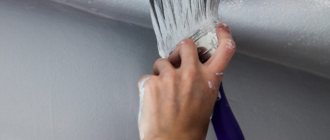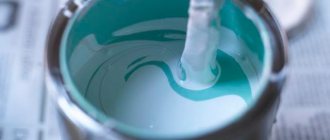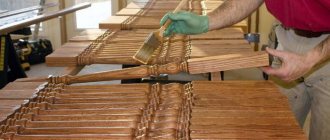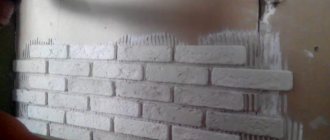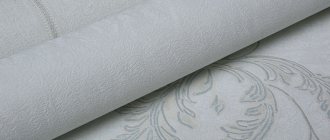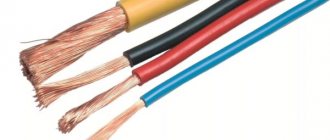How can you paint plaster?
By painting a plaster product you can achieve the desired look, stylize natural aging, and perform other effects that make the thing extraordinary.
There are special water-based plaster paints on sale that you can use without any special skills:
- acrylic;
- emulsion;
- dispersed.
They create a protective film on the surface and can be used inside the house, because... non-toxic and dry quickly.
To achieve effects, semi-professional products are used:
- Surik . A natural pigment of red-orange or red-brown color.
- Varnish . It can be applied over paint or soaked into an unpainted product. When using varnish, it is possible to obtain the appearance of aged marble.
- Potal . Used if the surface needs to be given the effect of gilding or old bronze.
- Coloring pigments . They are added to the gypsum solution to obtain even coloring throughout the entire mass. Used in the manufacture of decorative bricks.
It is better to apply paint to a fresh product. If time has passed, then you need to use a primer, which will increase the durability of the color.
How and with what to process gypsum
Treatment of gypsum surface.
Over time, this material loses its ability to retain moisture. Paint does not adhere well to such surfaces, so it is better to paint the plaster right away.
When working with a product that has lost its water-retaining properties, before painting it is necessary:
- Clean the surface and coat with primer. This can be a ready-made solution, purchased in a store, or prepared independently from PVA glue and water in a ratio of 1:4.
- Protect the product and give it strength by varnishing or painting the figurine with paints in accordance with the intended plan. If the image consists of a large number of details, it is recommended to first draw them with a simple pencil.
- Cover the painted plaster with a double layer of any varnish suitable for such work.
- It is necessary to paint in a room with good ventilation, where the finished product is left for a day until completely dry.
Please note: Painting doors: choosing a paint material, step-by-step instructions for painting, how to choose a color
To make painting gypsum products easier, you can use:
- spray gun for large surfaces;
- brushes for drawing details;
- cotton swabs or a sponge to obtain a stone texture on the surface.
Caring for painted figurines
After painting, garden figurines need proper care, otherwise the renewed coating will not last long. The main recommendations are:
- regularly brush off dust and dirt from the figures with a soft cloth or sponge;
- treat them with an antifungal compound a couple of times a season;
- periodically renew the protective varnish layer;
- For the winter, do not forget to put the figures in the storage room.
Garden figurines are an interesting, practical and durable way to decorate your home area. With regular painting and care, they will last for many years and will not deteriorate from the harmful effects of precipitation and sunlight.
How to make plaster stronger
For all its advantages, this material has one significant drawback - low strength.
To eliminate this defect, various additives and substances are used. You can make gypsum stronger in industrial conditions using plasticizer additives and gypsum hardening activators.
At home, you can use PVA glue for these purposes. For 1 kg of dry gypsum mixture you will need 50 g of glue and 0.5 liters of water. Dissolve the glue in water and add gypsum powder to the solution. To give additional hardness, coat the finished figurine with an acrylic primer.
How to paint plaster
Painting a plaster product.
Gypsum products must be painted, because... Over time, moisture evaporates from the surface and the plaster becomes yellow, stains remain on it after touching.
To color the gypsum mass, a coloring pigment is added to it during mixing. It must be added slowly, stirring the composition until a uniform color is obtained.
After drying, the product will have a lighter shade. In order to achieve a bright color, additional coating is used.
To paint a frozen product you will need:
- brushes of different diameters and shapes;
- sponge or cotton swab;
- sandpaper to give an aging effect;
- varnish;
- paints and other means to obtain the intended result;
- acrylic primer;
- a solution of wax with gasoline or turpentine to make the surface glossy.
Pay attention to: How to paint a kitchen countertop
The paint is applied in several layers. The more there are, the more intense the surface shade will be. It can be primed before painting. After painting, apply varnish and give the desired texture using artistic techniques.
Technology of applying paint to gypsum stone, preparing the stone for painting
Tinting gypsum stone before installation Source ytimg.com
Painting gypsum stone after its installation Source ogorodsadovod.com
Painting of decorative gypsum stone can be carried out both before and after its installation on the walls. There will be no significant differences in the technology of work; it is a matter of convenience in each specific situation.
Removing dust with a brush from plaster finish before painting Source laminatepol.ru
In order for the paint to adhere as desired, the decorative stone must be clean. Wipe it clean and remove any other unwanted dirt, including any glue residue. If there are chips or scratches that you want to get rid of, this should also be done before painting.
Dilute the gypsum mixture according to the instructions on the package and cover the problem areas with a spatula, finger or other tool convenient in this situation. Be sure to let these patches dry thoroughly before painting.
Primer for gypsum coating for pre-treatment before painting Source formako.ru
An optional, but desirable step is applying a primer. It will provide stronger, more reliable and durable adhesion of the dye and the surface of the stone. Two important points: the primer must be compatible with the paint, and it must be allowed to dry before painting.
How to paint plaster bronze
To give a plaster object a gilded effect, various methods are used:
- Paint the plaster figurine with water-based emulsion. After 24 hours, when the paint has dried, apply a gold acrylic coating over it.
- Use silver or gold powder, which is diluted with nitro varnish. Apply this mixture to a piece of plaster surface to determine the proportions. When you get the desired shade, coat the product in two layers.
- Buy decorative paint for plaster. To obtain a smooth, well-painted surface, things are primed and painted in several layers.
To create the effect of aged bronze you will need:
- acrylic primer or varnish;
- tassels;
- patina;
- bronze acrylic paint;
- White Spirit.
The product is primed in 2 layers and covered with bronze paint, drying for about a day. After this, the surface is painted with a bitumen patina, and its excess must be immediately removed using a rag soaked in white spirit or another solvent. The patina will remain in the grooves and grooves of the figurine. At the end, all this is covered with acrylic glossy varnish.
Acrylic paints
Acrylic paints are great for drywall. They are inexpensive, easy to apply, and very durable. Of course, such paints are somewhat inferior to compositions based on silicone and silicate, but they are well suited for interior decoration. The following paints received high marks from experts:
- DULUX MASTER LUX AQUA 40. This paint is the best option for painting plasterboard walls and ceilings. The main characteristic of the material is its light absorption. Thanks to this property, the paint is able to mask minor surface errors. The covering power of the composition is high enough that in order to get an ideal wall or ceiling, just a couple of layers are enough. Add here the absence of unpleasant odors during operation, acceptable consumption and environmental friendliness of the material - and you will understand why this paint is quite expensive.
- ALPINA RENOVA. The experts also liked the white paint for plasterboard ALPINA RENOVA. The main advantage can be considered the preservation of the original whiteness for seven years after painting the surface! However, you can add any color to the base, of course, produced by ALPINA - in this case, the paint will not turn yellow until the next repair. Caring for drywall painted with this composition is quite simple: it does not fade and is not afraid of dirt and dust. It is also important that painted surfaces withstand temperature changes and high humidity. The only thing that can be considered a drawback is the high consumption: about 250 grams per square meter.
- FARBITEX PROFI. This is a budget option for drywall paint for walls and ceilings. Its main ability is water-repellent, thanks to which the paint can be used in living rooms, as well as in the kitchen and bathroom. The consumption is quite economical: only 90-100 grams of paint are required per square meter. In addition, FARBITEX PROFI is characterized by a low price. The composition also has negative sides, for example, too thorough wet cleaning can lead to complete erasure of the coating.
What varnish to use for plaster products
The minimum coating for plaster is a layer of varnish. It will fix the natural color of the material, prevent moisture from evaporating, protect the item from destruction and help achieve an attractive appearance. Different types of varnishes can be used.
Shellac
Shellac varnish.
Alcohol based. Can be applied to any paint. It can be transparent and colored. With its help, the effect of aged marble is obtained. The melting point of the varnish is 80-120ºC.
Acrylic
This varnish comes in matte, glossy, and pearlescent. Safe to use, easy to apply, dries quickly. Creates a water-repellent film on the surface that protects against fading.
Resistant to high temperatures: changes color at 180ºC, begins to melt at 260ºC. After drying, it does not change color.
Pay attention to: Do-it-yourself technology for painting chimneys: choosing paint and step-by-step instructions for painting from different materials
Oil
With the help of artificial resins and plant substances included in the composition, it protects the surface. It comes in matte and glossy. Requires dilution with a solvent before use. After drying, it makes the surface darker than before application.
Glossy varnish brings solemnity to the interior. For those who favor naturalness, matte varnish is suitable.
Features of the material
Gypsum is a building material of natural origin. The mineral is extracted from the depths of the earth, burned, crushed to a powder state, and mixed with water until smooth. The use of gypsum mortar in construction is varied:
- wall covering;
- creation of stucco moldings, statues and other small artistic and architectural elements;
- casting bricks, decorative slabs;
- fastening elements at an intermediate stage of construction.
The standard color of the material is white or grayish-white. Plaster elements are used to decorate interior spaces, facades, and garden plots. With the help of plaster you can create a figure of any complexity and pretentiousness, in any style.
Expert opinion
Zakharova Irina Yurievna
Cleaning professional with 15 years of experience. Our best expert.
Ask a Question
During operation, it should be remembered that gypsum is destroyed by prolonged and abundant exposure to moisture.
The material is popular because it has many advantages:
- hardens quickly (therefore you cannot hesitate to complete the work);
- has a “breathing” porous structure;
- not exposed to direct flame;
- weighs little;
- easy to process, does not require complex installation measures;
- absorbs paint well and does not require complex painting procedures;
- environmentally friendly;
- is relatively inexpensive.
